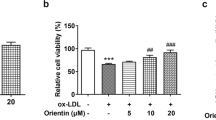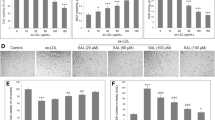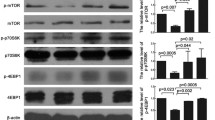Abstract
Background
Endothelial dysfunction induced by oxidized low-density lipoprotein (ox‐LDL) is implicated in the pathogenesis of atherosclerosis (AS). Activated autophagy was reported to improve endothelial functions and alleviate AS development. AMPK is a key protein in the regulation of autophagy, which can be modulated by Wnt signaling pathway.
Objective
Our study was designed to explore whether the canonical Wnt activator Wnt3a promotes autophagy in AS through in vitro and in vivo assays.
Results
Human umbilical vein endothelial cells (HUVECs) were first treated with ox‐LDL at 50 μg/mL for 24 h and then transfected with Wnt3a-overexpressed plasmid pcDNA3.1/Wnt3a. At 48 h after transfection, HUVECs were treated with 100 μM 3-MA. To investigate the effects of GSK-3β inhibition on the activation of AMPK, HUVECs were treated with 10 μM TWS119. Cell viability was detected via Trypan blue staining. Wnt3a expression, autophagy markers, GSK-3β inhibition and AMPK activation were examined by western blotting. To induce animal model of AS, male apolipoprotein E deficient (ApoE−/−) mice were fed with high-fat diet. pcDNA3.1/Wnt3a was injected into ApoE−/− mice after high-fat diet induction. Oil Red O staining was performed to examine lipid and plaque deposition in atherosclerotic lesions. In this study, ox‐LDL treatment decreased HUVEC viability and downregulated Wnt3a expression. Wnt3a overexpression promoted autophagy, induced GSK-3β phosphorylation at Ser9, and AMPK phosphorylation at Thr172 in ox-LDL-stimulated HUVECs. Overexpressing Wnt3a ameliorated lipid accumulation in aortic plaque of ApoE−/− mice. Furthermore, Wnt3a overexpression also activated autophagy, and induced GSK-3β and AMPK phosphorylation in ApoE−/− mice.
Conclusion
Wnt3a activates AMPK through inhibiting GSK-3β, thereby facilitating autophagy in AS.





Similar content being viewed by others
References
Acebron S, Niehrs C (2016) β-catenin-independent roles of Wnt/LRP6 signaling. Trends Cell Biol 26(12):956–967
Acebron S et al (2014) Mitotic wnt signaling promotes protein stabilization and regulates cell size. Mol Cell 54(4):663–674
Alvarez AR et al (2004) Wnt-3a overcomes beta-amyloid toxicity in rat hippocampal neurons. Exp Cell Res 297(1):186–196
Angers S, Moon R (2009) Proximal events in Wnt signal transduction. Nat Rev Mol Cell Biol 10(7):468–477
Bäck M et al (2019) Inflammation and its resolution in atherosclerosis: mediators and therapeutic opportunities. Nat Rev Cardiol 16(7):389–406
Badimon L, Borrell-Pages M (2017) Wnt signaling in the vessel wall. Curr Opin Hematol 24(3):230–239
Bhattacharya A, Eissa N (2015) Autophagy as a stress response pathway in the immune system. Int Rev Immunol 34(5):382–402
Chandramouleeswaran P et al (2020) Autophagy mitigates ethanol-induced mitochondrial dysfunction and oxidative stress in esophageal keratinocytes. PLoS ONE 15(9):e0239625
Chen M et al (2013) Resveratrol attenuates vascular endothelial inflammation by inducing autophagy through the cAMP signaling pathway. Autophagy 9(12):2033–2045
Cisternas P et al (2016) Activation of Wnt signaling in cortical neurons enhances glucose utilization through glycolysis. J Biol Chem 291(50):25950–25964
Dong Y et al (2010) Reduction of AMP-activated protein kinase alpha2 increases endoplasmic reticulum stress and atherosclerosis in vivo. Circulation 121(6):792–803
Endemann D, Schiffrin E (2004) Endothelial dysfunction. J Am Soc Nephrol 15(8):1983–1992
Ewart M, Kennedy S (2011) AMPK and vasculoprotection. Pharmacol Ther 131(2):242–253
Guo J et al (2021) LncRNA PVT1 knockdown alleviated ox-LDL-induced vascular endothelial cell injury and atherosclerosis by miR-153-3p/GRB2 axis via ERK/p38 pathway. Nutr Metab Cardiovasc Dis 31(12):3508–3521
Hamasaki M, Shibutani S, Yoshimori T (2013) Up-to-date membrane biogenesis in the autophagosome formation. Curr Opin Cell Biol 25(4):455–460
Hardie D, Schaffer B, Brunet A (2016) AMPK: an energy-sensing pathway with multiple inputs and outputs. Trends Cell Biol 26(3):190–201
Herrington W et al (2016) Epidemiology of atherosclerosis and the potential to reduce the global burden of atherothrombotic disease. Circ Res 118(4):535–546
Hua Y et al (2022) The induction of endothelial autophagy and its role in the development of atherosclerosis. Front Cardiovasc Med 9:831847
Jiang F (2016) Autophagy in vascular endothelial cells. Clin Exp Pharmacol Physiol 43(11):1021–1028
Kahn M (2014) Can we safely target the WNT pathway? Nat Rev Drug Discov 13(7):513–532
Kahn B et al (2005) AMP-activated protein kinase: ancient energy gauge provides clues to modern understanding of metabolism. Cell Metab 1(1):15–25
Klionsky D, Emr S (2000) Autophagy as a regulated pathway of cellular degradation. Science (new York, NY) 290(5497):1717–1721
Li D et al (2002) Statins modulate oxidized low-density lipoprotein-mediated adhesion molecule expression in human coronary artery endothelial cells: role of LOX-1. J Pharmacol Exp Ther 302(2):601–605
Li Y et al (2022) Autophagy-sirtuin1(SIRT1) alleviated the coronary atherosclerosis (AS)in mice through regulating the proliferation and migration of endothelial progenitor cells (EPCs) via wnt/β-catenin/GSK3β signaling pathway. J Nutr Health Aging 26(3):297–306
Meng Q et al (2021) Morin hydrate inhibits atherosclerosis and LPS-induced endothelial cells inflammatory responses by modulating the NFκB signaling-mediated autophagy. Int Immunopharmacol 100:108096
Osonoi Y et al (2018) Defective autophagy in vascular smooth muscle cells enhances cell death and atherosclerosis. Autophagy 14(11):1991–2006
Ou H et al (2018) Role of AMPK in atherosclerosis via autophagy regulation. Sci China Life Sci 61(10):1212–1221
Rajagopalan S et al (2004) Endothelial cell apoptosis in systemic lupus erythematosus: a common pathway for abnormal vascular function and thrombosis propensity. Blood 103(10):3677–3683
Ren J, Zhang Y (2018) Targeting autophagy in aging and aging-related cardiovascular diseases. Trends Pharmacol Sci 39(12):1064–1076
Ríos J, Godoy J, Inestrosa N (2018) Wnt3a ligand facilitates autophagy in hippocampal neurons by modulating a novel GSK-3β-AMPK axis. Cell Commun Signal 16(1):15
Schrijvers D, De Meyer G, Martinet W (2011) Autophagy in atherosclerosis: a potential drug target for plaque stabilization. Arterioscler Thromb Vasc Biol 31(12):2787–2791
Steinberg D (2009) The LDL modification hypothesis of atherogenesis: an update. J Lipid Res 50:S376–S381
Suzuki T et al (2013) Inhibition of AMPK catabolic action by GSK3. Mol Cell 50(3):407–419
Tabas I, Williams K, Borén J (2007) Subendothelial lipoprotein retention as the initiating process in atherosclerosis: update and therapeutic implications. Circulation 116(16):1832–1844
Takatani T et al (2011) AMP-activated protein kinase attenuates Wnt/β-catenin signaling in human osteoblastic Saos-2 cells. Mol Cell Endocrinol 339:114–119
Tang X et al (2022) Aloe-emodin derivative produces anti-atherosclerosis effect by reinforcing AMBRA1-mediated endothelial autophagy. Eur J Pharmacol 916:174641
Trpkovic A et al (2015) Oxidized low-density lipoprotein as a biomarker of cardiovascular diseases. Crit Rev Clin Lab Sci 52(2):70–85
Wu X, Won H, Rubinsztein D (2013) Autophagy and mammalian development. Biochem Soc Trans 41(6):1489–1494
Wu H et al (2021) Metformin attenuates atherosclerosis and plaque vulnerability by upregulating KLF2-mediated autophagy in apoE mice. Biochem Biophys Res Commun 557:334–341
Xia H, Green D, Zou W (2021) Autophagy in tumour immunity and therapy. Nat Rev Cancer 21(5):281–297
Xie Z, Klionsky D (2007) Autophagosome formation: core machinery and adaptations. Nat Cell Biol 9(10):1102–1109
Yan L et al (2022) Schisandrin B mitigates hepatic steatosis and promotes fatty acid oxidation by inducing autophagy through AMPK/mTOR signaling pathway. Metabolism 131:155200
Zhan W et al (2022) ANGPTL4 attenuates palmitic acid-induced endothelial cell injury by increasing autophagy. Cell Signal 98:110410
Zhang D et al (2018a) Autophagy maintains the integrity of endothelial barrier in LPS-induced lung injury. J Cell Physiol 233(1):688–698
Zhang L et al (2018b) H19 knockdown suppresses proliferation and induces apoptosis by regulating miR-148b/WNT/β-catenin in ox-LDL -stimulated vascular smooth muscle cells. J Biomed Sci 25(1):11
Zhang Y et al (2021) Dickkopf-2 knockdown protects against classic macrophage polarization and lipid loading by activation of Wnt/β-catenin signaling. J Cardiol 78(4):328–333
Acknowledgements
Not applicable.
Funding
The work was supported by Wuhan Municipal Health Commission (approval number: WX21B08).
Author information
Authors and Affiliations
Contributions
SQ and BN were the main designers of this study. KZ, NJ, and HL performed the experiments. BN analyzed the data. SQ drafted the manuscript. All authors read and approved the final manuscript.
Corresponding author
Ethics declarations
Conflict of interest
Shifang Qu declares that he/she has no conflict of interest. Kuanxin Zhang declares that he/she has no conflict of interest. Nan Jin declares that he/she has no conflict of interest. Han Li declares that he/she has no conflict of interest. Bin Nie declares that he/she has no conflict of interest.
Ethical approval
This article does not contain any studies with human participants performed by any of the authors. Animal experiments were granted by the Ethics Committee of Wuhan Myhalic Biotechnology Co., Ltd (Approval number: 202109136; Hubei, China).
Additional information
Publisher's Note
Springer Nature remains neutral with regard to jurisdictional claims in published maps and institutional affiliations.
Rights and permissions
Springer Nature or its licensor holds exclusive rights to this article under a publishing agreement with the author(s) or other rightsholder(s); author self-archiving of the accepted manuscript version of this article is solely governed by the terms of such publishing agreement and applicable law.
About this article
Cite this article
Qu, S., Zhang, K., Jin, N. et al. The activation of Wnt signaling facilitates autophagy by modulating GSK-3β-AMPK axis in atherosclerosis. Mol. Cell. Toxicol. 19, 721–729 (2023). https://doi.org/10.1007/s13273-022-00298-y
Accepted:
Published:
Issue Date:
DOI: https://doi.org/10.1007/s13273-022-00298-y




